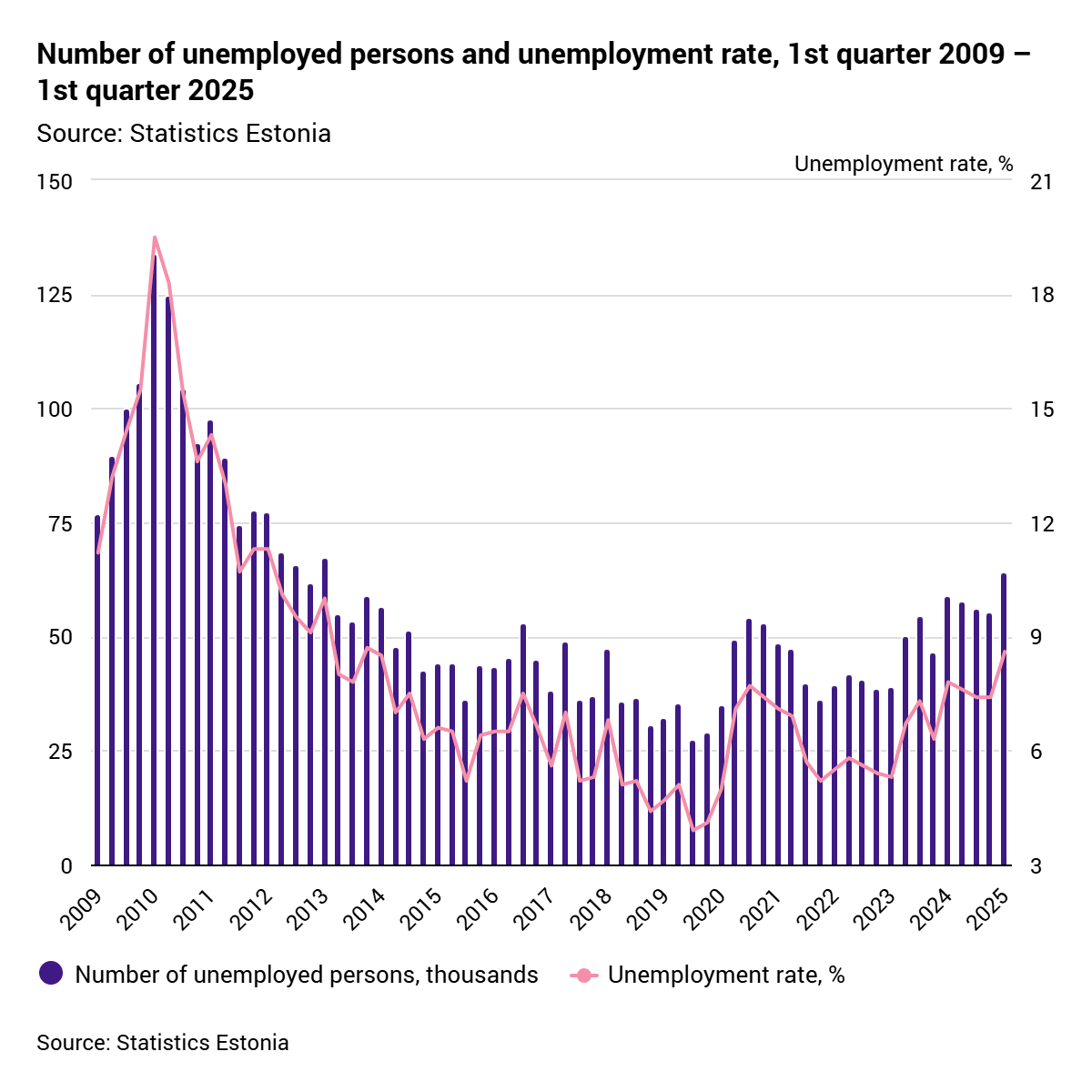The number of unemployed persons is at the highest level of the last 12 years
According to Statistics Estonia, in the first quarter of 2025, the unemployment rate was 8.6%, the employment rate was 67.4%, and the labour force participation rate was 73.7%.
Tea Vassiljeva, analyst at Statistics Estonia, explained that there were 64,200 unemployed persons in the first quarter of 2025, which is the highest value of this indicator in the last 12 years. “The number of the unemployed increased by 5,300 compared with the same quarter of last year. The unemployment rate rose to 8.6%, which is 0.8 percentage points more than a year earlier and 1.2 percentage points more than in the fourth quarter of last year,” noted Vassiljeva.
The unemployment rate was 9% for men and 8.2% for women. “Ida-Viru county was the only region where the unemployment rate decreased – it reached 12.7%, which is still the highest rate in Estonia despite the decrease,” said Vassiljeva.
The biggest rise occurred in the number of people who have unemployed for a year or more. In the first quarter, their number was 16,000, up by 3,200 compared with the first quarter of last year. “38,100 people had been unemployed for less than six months. Their number increased by 1,700 year on year and by 4,800 compared with the fourth quarter of last year,” said Vassiljeva.
The number of employed persons was 681,600 in the first quarter of 2025. Compared with the first quarter of last year, the number of employed persons was down by 11,700 in Estonia as a whole. Regionally, the number decreased the most in Southern Estonia (Jõgeva, Põlva, Tartu, Valga, Viljandi and Võru counties) and in Western Estonia (Hiiu, Lääne, Pärnu and Saare counties) and also in Tallinn. The employment rate, which shows the share of the employed among 15–74-year-olds (the working-age population), was 67.4% in Estonia and declined by one percentage point compared with the first quarter of 2024.
Overall, the number of employed persons decreased, with an increase recorded only in the services sector
“There were significant differences between regions. The employment rate increased in Harju county, excluding Tallinn, and in Central Estonia (Järva, Lääne-Viru and Rapla counties). The biggest rise, by 3.3 percentage points, was registered in Ida-Viru county which traditionally has a considerably lower share of employed persons than other regions in Estonia. Based on first quarter data, the employment rate decreased in Western Estonia, where it was down by 3.4 percentage points. The employment rate also declined in Southern Estonia and in Tallinn.
The number of employed women fell by 6,900 and the number of employed men by 4,800. Looking at sectors of economy, the number of the employed decreased in industry and construction and in agriculture, forestry and fishing. The number of employed persons increased in the services sector, which accounted for nearly three thirds (73.8%) of all employed persons.
The working-age population also decreased
Vassiljeva said that the number of employed persons decreased mainly on account of self-employed persons: compared with the first quarter of 2024, the number of employees fell by 1,000 while the number of self-employed persons without employees was down by 2,100 and the number of self-employed persons with employees decreased by 7,400.
“In the first quarter, the number of economically inactive persons – i.e. the population outside the labour force – grew by 4,300 year on year. The greatest increase in the inactive population was registered in Tallinn and in Southern Estonia. The number of inactive persons decreased in Ida-Viru county,” explained Vassiljeva. The labour force participation rate in Estonia was 73.7%, which is 0.5 percentage points lower than in the first quarter last year.
Since the population size decreased compared with 2024, there was also a decline in the working-age population – the total number of 15–74-year-olds fell by 1,900. The change in working-age population varied regionally. Compared with the first quarter of 2024, the working-age population decreased the most in Southern Estonia (down by 4,400) and Northeastern Estonia (i.e. Ida-Viru county; down by 1,900).
There was an increase in the working-age population in Central Estonia (up by 2,400) and in Tallinn (up by 2,000). Looking at the different age groups of the working-age population, the number of 15–24-year-olds rose by 4,300 and the number of 65–74-year-olds by 1,300, while the number of 25–64-year-olds fell by 7,600.
The Labour Force Survey statistics include permanent residents of Estonia who live or plan to live in Estonia for at least a year or more. The number of temporarily protected Ukrainian refugees included in the Labour Force Survey is too small to give estimates on them. More information about Ukrainians in the Estonian labour market can be found in the dedicated section of short-term statistics on our website.
N.B. The table TT2060 will no longer be updated after 15 May 2025. Statistics on the number of persons employed in the public and private sectors are published in tables PA105 and PA115. More detailed statistics about the public sector are published by the Ministry of Finance on its website.
More detailed data have been published in the statistical database. See also the labour market section on our website, and the labour market application of Statistics Estonia and the Ministry of Social Affairs at tooturg.stat.ee (in Estonian).
When using Statistics Estonia’s data and graphs, please indicate the source.
For further information:
Heidi Kukk
Media Relations Manager
Marketing and Dissemination Department
Statistics Estonia
Tel +372 5696 6484
press [at] stat.ee (press[at]stat[dot]ee)
